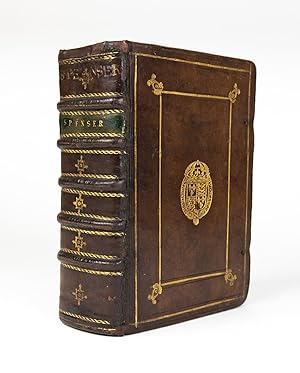About this Item
Bound in 17th c. calf, the boards gilt-ruled in compartments with ornamental tools at the corners and a large stamp of the Tudor arms at the center of each board (hinges and endcaps restored, corners bumped, later label, lacking ties). Inscriptions: In the Shepheards Calender 1. Contemporary signature of Roger Collings on p. 1; 2. Inscription in Latin on title page, "To the library of Lord John Bond as a gift by M[onsieur] Bloncq [i.e. Blanc] A.D. 1627". 3. Also on t.p., "Lady Carew" and "June 27, 1669" (perhaps Mary Morice of Wirrington (d. 1698), Lady Carew). 4. Unidentified armorial stamp on verso of t.p. For condition of contents, see individual entries below. 5. Another -and quite marvelous- contemporary inscription on the third preliminary leaf of the Shepheards Calender: "This is Robard Batmans Booke and he that steale et shall be hanged vpon A Roke as Hy as he cane loke.". I. THE SHEPHEARDS CALENDER. London: Printed by Iohn Windet, for Iohn Harrison the yonger, dwelling in Pater-noster roe, at the signe of the Anger, 1591. Quarto: [4], 52 lvs. Collation: *4, A-N4 (3 preliminary leaves supplied and genuine). FOURTH EDITION. (1st ed. pub. 1579). Title within woodcut border (McKerrow & Ferguson 198). The text is illustrated with 12 woodcut vignettes, one for each month. Restorations to inner margin of title with some loss to the lefthand portion of the woodcut border, small repair to upper, outer corner (no loss), 3 preliminary leaves following title supplied from a shorter copy (blank lower margin restored.) The woodcut for April shows Queen Elizabeth and her entourage. "This and the edition of 1586 are counterparts of each other… The illustrations are printed from the same blocks; the type, however, was reset, there being slight differences in spelling, etc., and the printer s ornaments at the foot of the eclogues are different." (Langland to Wither, No. 229, p. 199-200) "Published in 1579, a decade before The Faerie Queene , this book of pastorals established Spenser as the leading poet of his generation. Its editor, one "E.K." (never identified but clearly someone associated with Spenser), heralded the work as a major literary event and its author as our new poet. It was reprinted four times in Spenser's lifetime and evoked imitations and admiring comments almost from the date of its publication. Spenserians and traditional literary historians still take The Shepheardes Calender at E.K.'s valuation and treat it (not without reason) as inaugurating the great age of Elizabethan poetry… It was the first set of English pastorals in the European tradition, and in emulating Virgil's Eclogues, it self-consciously inaugurated a poetic career on the model of Virgil's-one that would move from a book of eclogues to a national epic."(Alpers, Pastoral and the Domain of Lyric in Spenser's Shepheardes Calender) " The Shepheardes Calender was entered into theStationers'register on 5 December 1579 and was published by the protestant publisherHugh Singletonsoon after that date, as the poem bears the imprint 1579 (indicating that it must have appeared before the end of February). The Calender was a popular work and was reprinted in 1581, 1586, 1591, and 1597, demonstrating thatSpenserdid make an impact as 'our new poet'. It contains twelve poems, complete with prefatory comments and notes byE. K., which may or may not have been written bySpenserhimself andGabriel Harvey, and a series of emblematic woodcuts of allegorical significance. The poems describe events in the lives of a series of fictional shepherds and vary from apparently personal laments on the nature of loss and unrequited love to stringent ecclesiastical satire and attacks on corruption and court patronage. They comment on the nature of love and devotion, the pains of exile, praise for the queen, forms of worship, the duties of church ministers, forms of poetry, the merits of protestantism and Catholicism, and impending death. Equally important is the showy technical p.
Seller Inventory # 4531
Contact seller
Report this item




